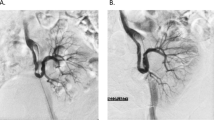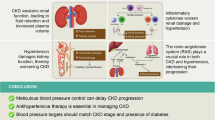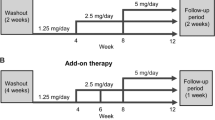Abstract
The effect of the calcium channel blocker azelnidipine on the redox status of a murine hypertension model was analyzed and imaged using in vivo low frequency electron paramagnetic resonance (EPR). A murine two kidney–one clip (2K1C) hypertension model was produced by a clipping of the right renal artery. The resulting hypertensive mice were treated with low-dose azelnidipine (1 mg/kg/d), with high-dose azelnidipine (3 mg/kg/d) or without azelnidipine (HT group). An EPR system equipped with a loop-gap resonator and an imaging system was employed. Redox status was evaluated as organ reducing activity measured by means of the decay rate (half-lives) of the spin probe 3-carbamoyl-2,2,5,5-tetramethylpyrrolidine-1-oxyl (Carbamoyl- PROXYL). Four weeks after clipping the mice demonstrated hypertension as expected. After the additional 2 weeks of azelnidipine treatments, the Carbamoyl-PROXYL half-lives of the Low and High azelnidipine groups measured in the upper abdominal area were significantly shorter than those of the HT group, suggesting improvements in the reducing activity. The blood pressures of the three groups showed no significant differences at this time, and there was no correlation between the renal reducing activity and either blood pressure or serum creatinine values. EPR imaging studies revealed that the improvement in abdominal reducing activity was mainly recognized in the kidney but not in the liver. These results indicate that azelnidipine ameliorates renal redox status through an improvement in reducing activity independent of blood pressure control.
Similar content being viewed by others
Article PDF
References
Halliwell B, Gutteridge JMC : Measurement of reactive species, in: Halliwell B, Gutteridge JMC (eds): Free Radicals in Biology and Medicine, 4th ed. London, Oxford Science Publications, 2007, pp 268–270.
Dikalov S, Griendling KK, Harrison DG : Measurement of reactive oxygen species in cardiovascular studies. Hypertension 2007; 49: 717–727.
Godfraind T : Antioxidant effects and the therapeutic mode of action of calcium channel blockers in hypertension and atherosclerosis. Philos Trans R Soc Lond B Biol Sci 2005; 360: 2259–2272.
Yokoyama H, Lin Y, Itoh O, et al: EPR imaging for in vivo analysis of the half-life of a nitroxide radical in the hippocampus and cerebral cortex of rats after epileptic seizures. Free Radic Biol Med 1999; 27: 442–448.
Togashi H, Matsuo T, Shinzawa H, et al: Ex vivo measurement of tissue distribution of a nitroxide radical after intravenous injection and its in vivo imaging using a rapid scan ESR-CT system. Magn Reson Imaging 2000; 18: 151–156.
Miura Y, Ozawa T : Noninvasive study of radiation-induced oxidative damage using in vivo electron spin resonance. Free Radic Biol Med 2000; 28: 854–859.
Hirayama A, Yoh K, Nagase S, et al: EPR imaging of reducing activity in Nrf2 transcriptional factor deficient mice. Free Radic Biol Med 2003; 34: 1236–1242.
Kuppusamy P, Li H, Ilangovan G, et al: Noninvasive imaging of tumor redox status and its modification by tissue glutathione levels. Cancer Res 2002; 62: 307–312.
Ueda A, Nagase S, Yokoyama H, et al: Identification by an EPR technique of decreased mitochondrial reducing activity in puromycin aminonucleoside–induced nephrosis. Free Radic Biol Med 2002; 33: 1082.
Utsumi H, Yamada K : In vivo electron spin resonance–computed tomography/nitroxyl probe technique for noninvasive analysis of oxidative injuries. Arch Biochem Biophys 2003; 416: 1–8.
Yamada K, Yamamiya I, Utsumi H : In vivo detection of free radicals induced by diethylnitrosamine in rat liver tissue. Free Radic Biol Med 2006; 40: 2040–2046.
Hirayama A, Nagase S, Ueda A, et al: In vivo imaging of oxidative stress in ischemia-reperfusion renal injury using electron paramagnetic resonance. Am J Physiol Renal Physiol 2005; 288: F597–F603.
Ueda A, Yokoyama H, Nagase S, et al: In vivo temporal EPR imaging for estimating the kinetics of a nitroxide radical in the renal parenchyma and pelvis in rats. Magn Reson Imaging 2002; 20: 77–82.
Matsui T, Yamagishi S, Nakamura K, Inoue H : Azelnidipine, a new long-acting calcium-channel blocker, inhibits tumour necrosis factor-alpha–induced monocyte chemoattractant protein-1 expression in endothelial cells. J Int Med Res 2006; 34: 671–675.
Nakamura K, Yamagishi S, Inoue H : Unique atheroprotective property of azelnidipine, a dihydropyridine-based calcium antagonist. Med Hypotheses 2005; 65: 155–157.
Nakano K, Egashira K, Ohtani K, et al: Azelnidipine has anti-atherosclerotic effects independent of its blood pressure–lowering actions in monkeys and mice. Atherosclerosis 2008; 196: 172–179.
Wiesel P, Mazzolai L, Nussberger J, Pedrazzini T : Twokidney, one clip and one-kidney, one clip hypertension in mice. Hypertension 1997; 29: 1025–1030.
Griendling KK, FitzGerald GA : Oxidative stress and cardiovascular injury. Part II: Animal and human studies. Circulation 2003; 108: 2034–2040.
Papaharalambus CA, Griendling KK : Basic mechanisms of oxidative stress and reactive oxygen species in cardiovascular injury. Trends Cardiovasc Med 2007; 17: 48–54.
Cifuentes ME, Pagano PJ : Targeting reactive oxygen species in hypertension. Curr Opin Nephrol Hypertens 2006; 15: 179–186.
Taniyama Y, Griendling KK : Reactive oxygen species in the vasculature: molecular and cellular mechanisms. Hypertension 2003; 42: 1075–1081.
Escobales N, Crespo MJ : Oxidative-nitrosative stress in hypertension. Curr Vasc Pharmacol 2005; 3: 231–246.
Mason RP, Walter MF, Trumbore MW, Olmstead EG Jr, Mason PE : Membrane antioxidant effects of the charged dihydropyridine calcium antagonist amlodipine. J Mol Cell Cardiol 1999; 31: 275–281.
Berkels R, Egink G, Marsen TA, Bartels H, Roesen R, Klaus W : Nifedipine increases endothelial nitric oxide bioavailability by antioxidative mechanisms. Hypertension 2001; 37: 240–245.
Spieker LE, Flammer AJ, Lüscher TF : The vascular endothelium in hypertension. Handb Exp Pharmacol 2006; 176 Pt2: 249–283.
Jinno T, Iwai M, Li Z, et al: Calcium channel blocker azelnidipine enhances vascular protective effects of AT1 receptor blocker olmesartan. Hypertension 2004; 43: 263–269.
Yamagishi S, Inagaki Y, Nakamura K, Imaizumi T : Azelnidipine, a newly developed long-acting calcium antagonist, inhibits tumor necrosis factor-alpha–induced interleukin-8 expression in endothelial cells through its anti-oxidative properties. J Cardiovasc Pharmacol 2004; 43: 724–730.
Lee MC, Shoji H, Miyazaki H, et al: Assessment of oxidative stress in the spontaneously hypertensive rat brain using electron spin resonance (ESR) imaging and in vivo L-band ESR. Hypertens Res 2004; 27: 485–492.
Sano T, Umeda F, Hashimoto T, Nawata H, Utsumi H : Oxidative stress measurement by in vivo electron spin resonance spectroscopy in rats with streptozotocin-induced diabetes. Diabetologia 1998; 41: 1355–1360.
Han JY, Takeshita K, Utsumi H : Noninvasive detection of hydroxyl radical generation in lung by diesel exhaust particles. Free Radic Biol Med 2001; 30: 516–525.
Okajo A, Matsumoto K, Mitchell JB, Krishna MC, Endo K : Competition of nitroxyl contrast agents as an in vivo tissue redox probe: comparison of pharmacokinetics by the bile flow monitoring (BFM) and blood circulating monitoring (BCM) methods using X-band EPR and simulation of decay profiles. Magn Reson Med 2006; 56: 422–431.
Yamada K, Inoue D, Matsumoto S, Utsumi H : In vivo measurement of redox status in streptozotocin-induced diabetic rat using targeted nitroxyl probes. Antioxid Redox Signal 2004; 6: 605–611.
Fuchs J, Groth N, Herrling T, Zimmer G : Electron paramagnetic resonance studies on nitroxide radical 2,2,5,5-tetramethyl-4-piperidin-1-oxyl (TEMPO) redox reactions in human skin. Free Radic Biol Med 1997; 22: 967–976.
Schafer FQ, Buettner GR : Redox environment of the cell as viewed through the redox state of the glutathione disulfide/glutathione couple. Free Radic Biol Med 2001; 30: 1191–1212.
Hirayama A, Yoh K, Ueda A, et al: Nrf2 deficiency intensifies early phase renal damage in streptozotocin-induced diabetic mice. Free Radic Biol Med 2004; 37: S134.
Bjelakovic G, Nikolova D, Gluud LL, Simonetti RG, Gluud C : Mortality in randomized trials of antioxidant supplements for primary and secondary prevention: systematic review and meta-analysis. JAMA 2007; 297: 842–857.
Author information
Authors and Affiliations
Corresponding author
Rights and permissions
About this article
Cite this article
Hirayama, A., Ueda, A., Oteki, T. et al. In Vivo Imaging of Renal Redox Status during Azelnidipine Treatment. Hypertens Res 31, 1643–1650 (2008). https://doi.org/10.1291/hypres.31.1643
Received:
Accepted:
Issue date:
DOI: https://doi.org/10.1291/hypres.31.1643



